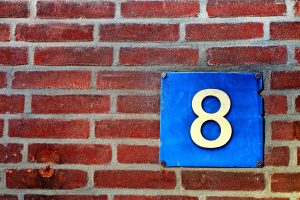Blog
What’s in a House Name (or Number)?

Every home in England has to have one – and you could get in trouble if it isn’t clearly displayed. We’re not talking about a water or electricity supply (although it must be considered fit for human habitation) but about your house name or number.
Here Norfolk removal company Hamiltons Removals, who have been helping people move to houses all across the UK for almost 30 years, look at the history of house names and numbers in this country, and what, if anything, you are allowed to do about changing it.
From Numbers…
The trend for house numbering in the UK first really took hold in large towns and cities, where a lot of houses were built at the same time. Before the 18th century, when the population was smaller, names were enough. However, once homes were built in large numbers, there had to be a quick and easy method of identification, so a numbering system was introduced. This was established by an Act of Parliament in 1765.
Typically, houses on the left side of the street were given odd numbers and houses on the right side even numbers, with the lowest numbers usually nearest to the town centre. However, this hasn’t always the case – some older cul-de-sacs are numbered consecutively. Perhaps the best example of this is Downing Street in London, where the Prime Minister’s official residence is No. 10 and the Chancellor of the Exchequer’s is next door at No. 11.
…to Names
However, the growth of suburban housing, which was accelerated by the rail network, meant that there was a big rise in the number of new homeowners. Numbering wasn’t an option for many of these new suburban houses as they weren’t built in complete streets but one at a time, in line with individual demand. This meant the new class of homeowner had the opportunity to choose their own house name. So, what were the most popular choices?
A Trade or a Previous Use – sometimes people named their houses after their profession, which is why you see so many properties called School House, Mill House, The Old Forge or The Old Bakery. Sometimes the property may have originally been used for that purpose, but it has since been converted into housing as demand for these old trades diminished.
Another Place – before the growth in private housing, the only people who had any say in what their houses were called were the landed gentry, and the names of their stately homes were usually taken from the nearby village.
The new breed of homeowner was happy to continue this principle by using another place name. This could be somewhere local, or hundreds of miles away – giving rise to unlikely combinations, such as Clovelly Cottage, Finchley (North London and Devon are 225 miles apart). Often the borrowed name is from a beauty spot.
The Rural Idyll – many of the most popular house names today have natural themes – such as Rose Cottage, Orchard House, Yew Tree Cottage or The Firs. Some are named after animals and birds, such as Rookery Nook and Badgers Cottage. Often these are chosen by homeowners who have retired to the country, or just because they wanted a pleasant-sounding name.
Recent Crazes – tastes change, and many people choose house names for more recent, cultural reasons. For instance, during the past decade there has been a big rise in the number of homes with Harry Potter themes, or the TV series Poldark and Game of Thrones.
Can I Add a House Name?
The short answer is yes – but only if the local council and Royal Mail say so. You have to stay with your original house number (if you have one) so the emergency services know where to come. However, you are allowed to add a name on top of that, provided no one else has already claimed it.
If the Royal Mail give their approval, you will have to tell the Land Registry, your utility providers and the Electoral Roll. There may be some administrative expense involved. Once all that’s done, you can tell everyone about your new house name.
UK House Removals from Hamiltons Removals
Wherever you want to move to in the England, Norfolk removal company Hamiltons Removals will be able to help. We can offer free online removals quotes – for more details, click here – and you can also book a free video survey with us at a time to suit your own convenience (and which avoids any issues with social distancing).
We can also help you whether if are considering moving to Scotland or Wales. To get in touch, follow this link or call us on 01379 855203 or email us on info@hamiltonsremovals.co.uk.
« Back







